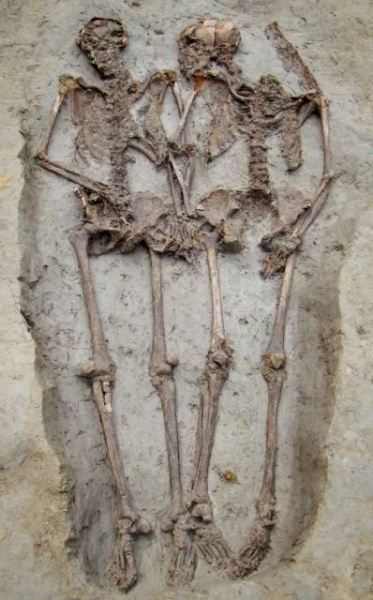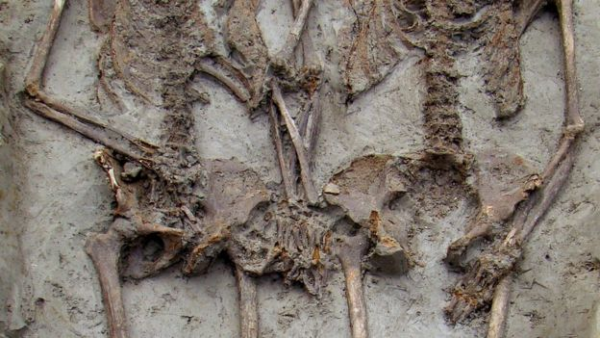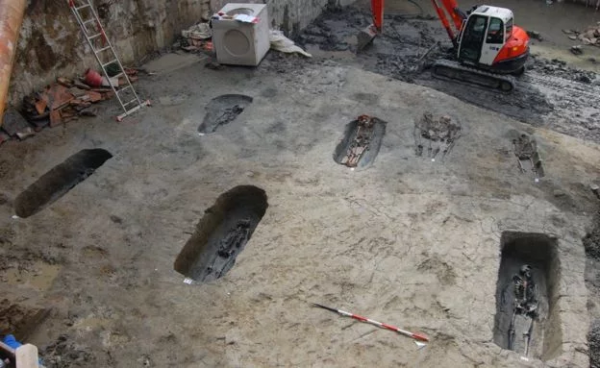Researchers Discover That The 15,000-Years-Old ‘Hand-Holding Skeletons’ are Both Male
In 2009, scientists in Italy unearthed two skeletons in the Ciro Menotti cemetery in Modena, Italy. What made their discovery remarkable is that not only were they buried together, but they were also holding hands. The two sets of remains were dubbed ‘the lovers of Modena’, and have long been assumed to the skeletons of a man and a woman, although both sets of bone were very poorly preserved, according to Ancient Origins.
Recently, however, researchers from the University of Bologna have proven that isn’t the case. In fact, both sets of remains are male.
The researchers in question did an analysis of the tooth enamel on both skeletons and published their finding in the journal Nature. The results of their work not only identified the remains’ sexes, but also that they lived sometime during the 4th-6th century AD.
There are people who immediately concluded that the men must be lovers, but that isn’t necessarily the case. They could just as easily have had some other close relationship, such as close friends or family. Others have speculated that they may be fellow soldiers, and that their burial site is part of a war cemetery.

The two bodies were intentionally laid to rest hand-in hand, which has never been seen before in cases where both parties are of the same sex. There have been other cases of remains being found in the same position in other parts of the world, but those have always been mixed-sex couples, which is why the same assumption was initially made in this case.
This unique burial may be able to help historians learn some new things about burial practices in Italy during that time period.
The typical way to identify the gender of a set of skeletal remains is to examine its pelvis and ribs, but that wasn’t possible in this case, due to the poor state of preservation.
In 2018, a study was led by the University of California, in which applied spectrometry was used to look for two specific proteins in the skeletons’ tooth enamel, as an alternative method for determining their genders. One of those two proteins, AMELX, is present in the enamel of both men and women, and the other protein, AMELY, is only present in the tooth enamel of men.
The second protein was found in the enamel of both sets of teeth, positively identifying the remains as male.

The skeletons belonged to people of similar age, but the study said that there wasn’t any real way to figure out what their exact relationship may be.
Many media outlets very quickly leapt to the conclusion that the men must be lovers, but that seems highly unlikely. There was huge social stigma against gay relationships during the period these men were alive, and even laws that specifically forbade gay sex.
If they had been lovers, it’s highly unlikely that the people who conducted their burial would know about it, let alone bury them in such an intimate position.
The pair was found along with 11 other skeletons, some of which were damaged in ways that suggested they died of trauma, such as would happen if they died in battle, which does help reinforce the idea that the pair might have been soldiers.
The fact that they were buried together strongly suggests that, whatever the specifics of their relationship, they shared a very close bond, whether they were good friends, siblings, comrades in battle, or even twins who went out of the world the same way they entered it — together.

Regardless of the specifics of their relationship, researchers say that the burial represents ‘a voluntary expression of commitment between two individuals’, and not a recurring burial practice of the time. The very oddity of the burial may prove to be the starting point for further investigations into the funerary practices in Italy during the late Antiquity period.
It’s certainly true that with each new, small clue researchers obtain from the relics of our distant past, the easier it becomes for them to see the larger picture of mankind’s history.
Another Article From Us: Thawing Permafrost Could See Anthrax & Prehistoric Diseases Return
Perhaps, as technology and science continue to advance, this mysterious pair will be able to provide further clues about who they were and what life was like when they were living.





